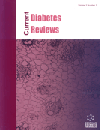- Home
- A-Z Publications
- Current Diabetes Reviews
- Previous Issues
- Volume 21, Issue 3, 2025
Current Diabetes Reviews - Volume 21, Issue 3, 2025
Volume 21, Issue 3, 2025
-
-
Effect of Novel Laser Shoe Photobiomodulation on Neuropathic Pain and Plantar Pressure Profile in Type 2 Diabetes Mellitus with Peripheral Neuropathy
More LessBackgroundPhotobiomodulation (PBM) or Low-level laser is used to treat diabetic foot complications. The existing method of laser application to the foot did not cover the foot's entire area to improve the foot's microcirculation. Therefore, we have developed a cost-effective Special LASER Shoe device, focusing exclusively on the entire foot region to manage neuropathic pain and other symptoms in individuals with type 2 diabete Read More
-
-
-
Unraveling the Therapeutic Potential of Muscle Strengthening Exercises for Reversing Diabetes Mellitus
More LessAuthors: Haajeera Samsudeen, Shree Pavithra De Varaj and Krishnaveni KandasamyBackgroundMillions of people worldwide are affected by the serious consequences of diabetes mellitus, which is a major global health concern. We analyze the possibility of muscle-strengthening activities as an appropriate therapeutic strategy for controlling the progression of diabetes mellitus in this comprehensive review. In this review, we explore the molecular processes underlying the glucose uptake in skeletal muscle, reve Read More
-
-
-
Prevalence and Predictors of Diabetic Peripheral Neuropathy in Newly Diagnosed Type 2 Diabetes Mellitus Patients
More LessAimThe present study aimed to determine the prevalence and predictors of DPN in newly diagnosed T2DM patients.BackgroundDiabetic Peripheral Neuropathy (DPN) is the most common and debilitating complication of Type 2 Diabetes Mellitus (T2DM).MethodsNewly diagnosed T2DM patients visiting the outpatient department were recruited. Detailed demographic parameters, histories, physical examinations, and biochemical Read More
-
-
-
Effects of Diabetes and Hyperlipidemia in Physiological Conditions - A Review
More LessAuthors: Sayan Hazra and Gunosindhu ChakraborthyBackgroundDiabetes mellitus (DM) is an autoimmune manifestation defined by persistent hyperglycemia and alterations in protein, fatty substances, and carbohydrate metabolism as an effect of problems with the secretion of insulin action or both. Manifestations include thirst, blurred eyesight, weight loss, and ketoacidosis, which can majorly lead to coma. There are different types of diabetes according to class or by c Read More
-
-
-
Using Machine Learning and Artificial Intelligence to Predict Diabetes Mellitus among Women Population
More LessBackgroundDiabetes Mellitus is a chronic health condition (long-lasting) due to inadequate control of blood levels of glucose. This study presents a prediction of Type 2 Diabetes Mellitus among women using various Machine Learning Algorithms deployed to predict the diabetic condition. A University of California Irvine Diabetes Mellitus Dataset posted in Kaggle was used for analysis.MethodsThe dataset included eight risk fa Read More
-
-
-
Qatar's Silent Epidemic: A Comprehensive Meta-analysis on the Prevalence of Metabolic Syndrome
More LessAuthors: Sarah Aqel, Jamil Ahmad, Sebawe Syaj, Majd N. Daoud and Bashar AraiqatBackgroundMetabolic syndrome comprises various conditions like abdominal obesity, insulin resistance, elevated triglyceride levels, reduced HDL, and high blood pressure, which pose significant health challenges globally. It's imperative to determine its prevalence in specific populations to formulate effective preventive measures.ObjectiveThis systematic review and meta-analysis aimed to determine the prevalence of met Read More
-
-
-
Diabetic Retinopathy - Pathophysiology to Treatment: A Review
More LessAuthors: Randhir Singh, Aditya Walia, Jasleen Kaur, Praveen Kumar, Inderjeet Verma and Nidhi RaniDiabetic retinopathy (DR) is a microvascular disease affecting the eyes of diabetic patients, and is the most prevalent complication of diabetes mellitus. Vision improvement is not possible in the majority of DR patients. Several studies have indicated that microvascular changes, inflammation, oxidative stress, and retinal neurodegeneration are involved in the pathogenesis of DR. Therefore, there is an urgent nee Read More
-
-
-
Herbal Nanoformulations for Diabetes: Mechanisms, Formulations, and Clinical Impact
More LessAuthors: Sunita, Rahul Kaushik, Krishan Kumar Verma and Rehana ParveenBackgroundDiabetes mellitus remains a global health challenge, demanding innovative therapeutic strategies. Herbal remedies have garnered attention for their potential in diabetes management, and recent advancements in nanotechnology have enabled the development of herbal nanoformulations with enhanced efficacy and bioavailability.ObjectiveThis review aimed to comprehensively analyze the mechanisms, fo Read More
-
-
-
Interferon Upregulation Associates with Insulin Resistance in Humans
More LessIn humans, insulin resistance is a physiological response to infections developed to supply sufficient energy to the activated immune system. This metabolic adaptation facilitates the immune response but usually persists after the recovery period of the infection and predisposes the hosts to type 2 diabetes and vascular injury. In patients with diabetes, superimposed insulin resistance worsens metabolic control and promotes Read More
-
-
-
The Teachers’ Knowledge of Type 1 Diabetes in Schools: An Interventional Study
More LessAuthors: Imane Assarrar, Dounia Zerrouki, Imane Rami, Najat Draoui, Salma Derbel, Nada El Yamani, Siham Rouf and Hanane LatrechBackgroundManaging type 1 diabetes in school is a real challenge for teachers, parents, and students themselves. Involving school educators in providing care and support is becoming more of a necessity than a luxury to facilitate access to healthcare services in schools for children with type 1 diabetes.ObjectivesOur work aimed to assess the background knowledge of teachers on type 1 diabetes and evaluate the impact of a Read More
-
Volumes & issues
-
Volume 21 (2025)
-
Volume 20 (2024)
-
Volume 19 (2023)
-
Volume 18 (2022)
-
Volume 17 (2021)
-
Volume 16 (2020)
-
Volume 15 (2019)
-
Volume 14 (2018)
-
Volume 13 (2017)
-
Volume 12 (2016)
-
Volume 11 (2015)
-
Volume 10 (2014)
-
Volume 9 (2013)
-
Volume 8 (2012)
-
Volume 7 (2011)
-
Volume 6 (2010)
-
Volume 5 (2009)
-
Volume 4 (2008)
-
Volume 3 (2007)
-
Volume 2 (2006)
-
Volume 1 (2005)
Most Read This Month
Article
content/journals/cdr
Journal
10
5
false
en


